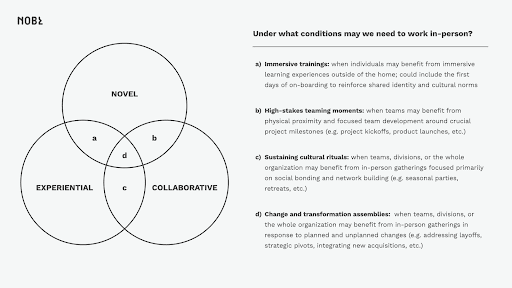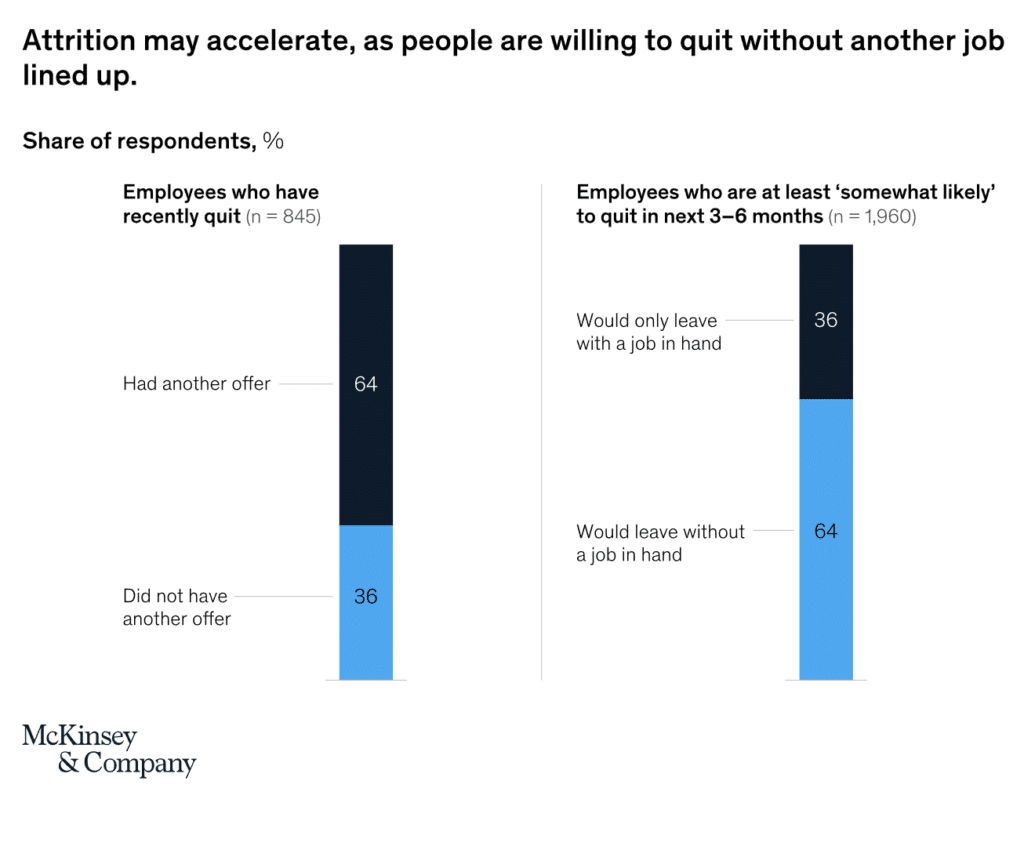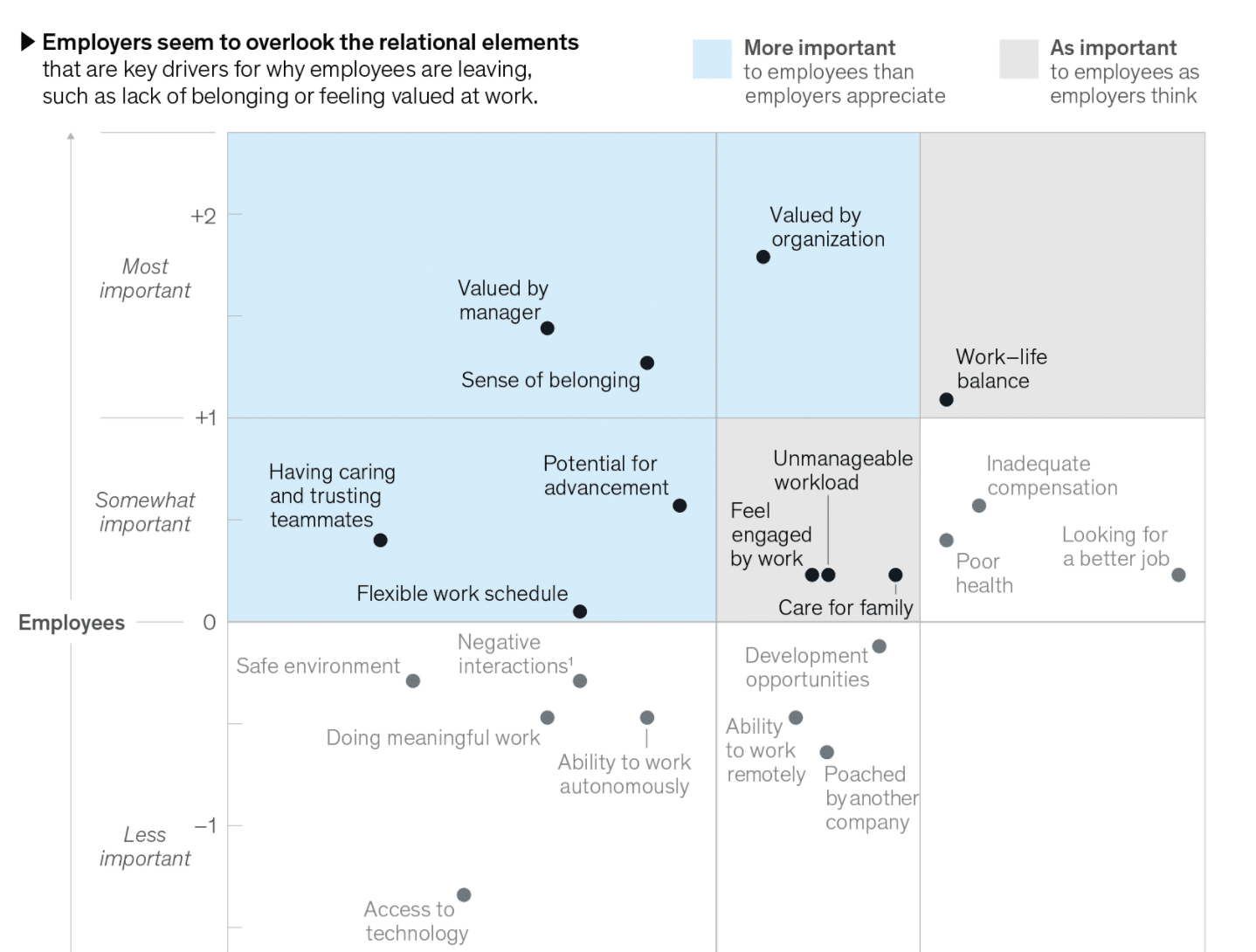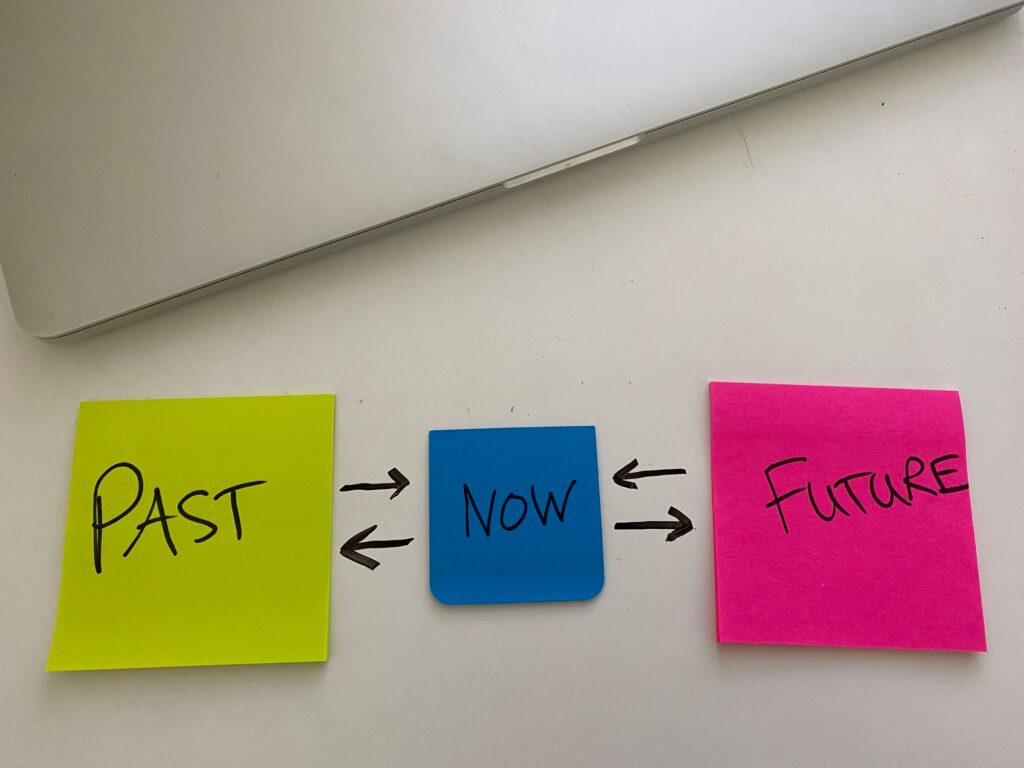

August 14, 2023
Culture of Chaos ,Great cultures ,Productivity
The question in hybrid work is when should we bring people to the office instead of letting people stay at home?
The brilliant people at NOBL figured out a great model, based on what type of work actually needs to be accomplished (which is so refreshing compared to dialogue about how many days).

Novel:
The task or challenge is new; there may not be an established process. When it’s new, there can be a lot of fear and anxiety and it’s easiest to relieve emotional discordance in person. It’s also very hard to read tone over the text of email or Slack. This is where hybrid work switches to in person.
Experiential:
An immersive experience can possibly be more effective. This is especially helpful if you do anything tactile.
Collaborative:
When tasks require sustained synchronous participation among a group. So obvious and yet with hybrid work, everyone is still obsessed with staying at home. It’s truly hilarious that Zoom is having trouble getting people to come into the office. The problem is they haven’t created a great collaborative culture such that people actually want to come to the office. (There’s a lot of room for creativity here).
Hybrid work culture can include: team building, annual strategy meetings, and change initiatives. And remember, if it’s important, put it on the calendar!
Going into the office is supposed to be a great experience! Where are you falling short?
I’ll tell you one way is to upgrade the coffee. I need to do an article on this because the CEO of United Airlines recently said that what motivated him to start making serious changes was hearing the airplane stewards say they were tired of apologizing for the bad coffee.
As always, remember that culture is co-created. So don’t think you have to figure this out all on your own. You can crowdsource the ideas and then experiment.
February 2, 2023
Culture of Chaos ,Great cultures ,Vision

Employee Engagement has always been the talk in HR and culture circles. And I’m glad that’s the word rather than “happiness.” I think we’re all responsible for our own happiness. But leaders can create a very engaging work environment. In some of the strongest work cultures, people aren’t always having fun, but they always care. They’re dedicated, and they’re focused. They act like they’re owners of the business.
Employee Engagement is not surveys (that usually just stay in Google Docs).
It’s not get-to-know-you games.
It’s not gifts and recognition.
It’s simply real and honest conversation.
That said, it needs a structure to create safety for the truth to emerge. The best way I know is an open source format that anyone can use. It’s called Open Space. Check it out…
www.OpenSpace.events You can follow the manuals there, or I’m happy to run an Open Space (and train you to do it without me). It can even be done virtually.
March 31, 2022
Culture of Chaos ,Great cultures ,Hacks ,Productivity
In high performance companies, HR often has to remind people to take their time off because they spend so much time at work.
The problem is that these high performers see vacations as a luxury, as opposed to a productivity hack that helps the company.
Think about it this way – Do you usually get more or less done right before a vacation? A lot, right?
So if HR (or managers) proactively address this before burnout, it will make the individuals more productive.
So pull each person aside and say, “I’d like you to plan your vacation that you’ll take 3 months from now.” It will probably make them nervous, but explain to them that:
a) This will make them more productive so they will get things done before the vacation starts and
b) It helps the team because if anyone is so crucial they can’t even miss a week, then the team is not resilient. This forces the team to be resilient by making sure the operations are covered.
So go ahead, while it’s on your mind. Set up those meetings to ask people to proactively schedule their vacations.
October 6, 2021
Culture of Chaos ,Uncategorized ,Vision
 This started out as a post about the Great Resignation. We may see most people exit the workforce for one reason or another.
This started out as a post about the Great Resignation. We may see most people exit the workforce for one reason or another.
People have become used to government payments, staying at home, and they’re unwilling to tolerate poor working conditions. Others are opposed to medical policies. And some are simply re-thinking their life. If they put their new checks into investments at the beginning of this year, then they really have flexibility.
So what does this mean?
And if you’re looking for a company engagement survey to save you, you’re about six months too late.
Now… don’t panic.
Why? Well for one, it never works. No one ever looked back and said, “I’m glad I completely freaked out and lost my shit over that.” If anything, it’s the actions they took as a result that made the difference.
It reminds me of a story about big wave surfers. When they are under a 60 foot wave, and can’t get back to the surface, they may be pummeled by yet another wave. And even though they can hold their breath for five minutes, it still might not be enough. So what’s the first thing they do? Relax.
Yes, relax. Because it’s a simple equation. If they freak out, then their heart beats fast and uses up all of their oxygen then they’ll die. The only chance they have to survive, is to be calm. So point 1…
You secure your own mask before helping your baby. Why? So you don’t pass out in the process. Take a look at your own life. Are you taking care of the basics. That really comes down to eat, sleep and exercise. Establish your baseline, so that you can get a clear emotional perspective.
The second reason not to panic is because things are far worse than you think. (Didn’t see that coming, did you?). Yes, we’re talking a sea of converging issues – A potential global debt collapse. Supply line issues that could leave people starving. Tense foreign. A President who isn’t “all there.” I could go on… In other words, we’re in a cesspool of struggle with no strong leadership.
So why on Earth would I turn up the pain on you this way?
Because a slow boiling frog dies. Turn up that burner and the frog jumps out. So let me say the second step, which you might find familiar.
What this means is a very personal choice. But make the choice. It can be as little as having a couple months of food and water, or it can mean all out prepper survival. The big question is really, what would help you sleep at night? For me, it’s a few things:
a) Three months of food and water
b) Back-up generator
c) Cash on hand
d) Taking money out of the market and into gold
e) Personal protection
Depending on who reads this, this will sound like too much or too little. But the question is this:
As a leader, you want to get there, so that everything coming out of your communications is from a place of confidence in your own safety so that you can give that safety to others.
You may even consider sharing your plans or helping them do the same. We have a lot of loyalty to those who truly look out for us.
Most of what your people are thinking is either happening between employees, or even worse, in their own heads. Much like the way you gain control of a car by turning in the direction of the skid, you want to actually want to authorize and create space for these conversations. The best tool I know for this is open space, or on a small team, it’s called lean coffee.
All it takes is a simple question and the freedom and safety to have any conversation. The question could be as focused as hitting a key crucial target, or as simple as
“What do we do now?” or “How can we be ready for anything?”
The amount of relief alone from talking this freely will do wonders.
Beyond that, people make new connections, and have new ideas you wouldn’t have even imagined. This is a far different experience than what they’re used to: Sitting in a conference hall in the dark while executives give an “inspiring” speech about the future.
Luckily, most of the things people want are within your control. (See that upper left corner)

You’ll get to read the results of these sessions and see which ones you want to empower. You’ll see what experiments you can run. You can consider new pivots in products or business lines. (Contact me about “How to Disrupt an Industry” if you’d like to know more).
It’s time we realized that life is not going back to normal. Even once the chaos ends, we’re looking at a new world by the end of this chaos.
Does this scare you? Good. Let’s turn that fear into excitement.
March 1, 2021
Culture of Chaos ,Vision
When Pinterest pays $90 million dollars to get out of a lease (and this somehow registered as good business), then you know things are changing.
Companies that don’t need to go back to the office won’t. They’ll invest in off-sites on a yearly or quarterly basis to align their teams. Some will have small offices with a lot of meeting rooms, kitchens and creative spaces. Other than that, it’s all about getting better at defining the remote work culture.
Calling it “remote work” actually hurts the company because it enforces the notion that we’re all alone. A better term to use would be distributed workforce, or the networked company.
Whatever you call it, the shift has actually exacerbated any problems a company had before the pandemic. Bad meetings are now intolerable. Unclear accountabilities are now pain points. Defining roles, responsibilities, expectations and boundaries are extremely important now.
May 19, 2020
Culture of Chaos

What COVID has done is increase the speed of a timeline that was already happening.
That timeline is decreasing the amount of time that is the NOW. The NOW is getting smaller and smaller, shorter and shorter in duration.
For example, in the early days of America, news cycles went in weeks if not months. We’re now seeing news cycles that last less than a day. Our expectations have changed. We want everything now and on-demand (remember when you actually had to wait till something was on TV live to watch it?). So the space between the past and the future is getting smaller and smaller.
This concept is well developed in my friend Jim Selman’s book, Living in a Real Time world. He outlines the core mindsets and behaviors to live in this new time. My thoughts are inspired by his work (though there is no crossover).
The new reality:
-We all have a new channel (virtual communications)
-We all have a new audience (an at-home audience)
-We all have a new timeline (if it’s not relevant now, it’s just not relevant).
New mindsets include:
-Lack of patience (ironically with more time, comes greater chance of changing channels)
-Online fatigue (zoom calls get exhausting)
-General sense of unease (even for the best of us)
Here are my tips on how to be and stay relevant.
Ever read a book and thought, “That really could have been just an article.” Take that further out. No one wants to hear all the intros and bios, and backstories. Get straight to the point. Get to the value. If you have a podcast, start with a cold open, like Breaking Bad. Give us the juice from the middle that makes us hungry to know the whole thing. Running a call or a webinar – what value can you give me immediately so I am confident to invest more of my time?
Everyone loves funny. It works in all markets. And we inherently trust those who are able to laugh at themselves and others (in a grounded way. Not in a psycho, Tiger King Carole kind of way). And notice I didn’t write, “Try to be funny.” I mean actually be funny. I know, that’s ridiculous to say because even the best stand-up comedians don’t know what’s funny until they test it with an audience. That’s why they don’t focus on funny. The focus on truth. They focus on their own unique points of view. They focus on being true to their voice. AND… they don’t take themselves or others so freakin seriously. Relax. I’ve spent 10 years in improv comedy, and the funny always comes from being authentic, open and listening deeply. Funny is a side effect.
You can get away with slow talking speeds in face to face to world. Online – you’re getting boring by the second. Facebook is just one click away from whatever you want them to focus on. Talk a little faster, but play with speed, tone and volume so you don’t hypnotize the audience (and yourself) by staying at the same levels. Take that long story you love to tell and compress it down to the key points. Learn to talk in sound bites. You can always go longer if you’re in the flow, but going longer isn’t a skill. Anyone can do long. It takes mastery to get down to the simple elegance. It took a lifetime of long equations for Einstein to get to E=mc2.
Dan Mezick said, “Everyone loves a coherent explanation, even when that coherent narrative is… a fabrication.” Think about it from a nervous system perspective. We respond well to leaders who are calm, collected, grounded, and tell us a story we can understand. Now contrast that with someone losing their shit, spouting a bunch of facts that people can’t follow. Even if this person tells the truth, they won’t be believed. I can’t believe how many articles I’ve seen on COVID that I can’t even follow because the narrative gets so distorted in all the point/counterpoints. I tune out.
If you didn’t catch the reference, it’s a play off Bill Clinton’s campaign mantra, “It’s the economy, stupid.” He made the point that even though all the debate and rhetoric was on politics, it’s really the economy that’s important to people’s everyday life and livelihood.
The equivalent today is that it’s not about the video. It’s the audio! We can tolerate bad video, but when audio is not pristine, we lose touch with it. We trance out. It doesn’t FEEL Real. You want it to feel as real as possible. So if you do anything online (I mean even date online – this will help for that too). GET A GOOD MIC. You can get amazing microphones for less than $100.
Those are my tips. What are yours?